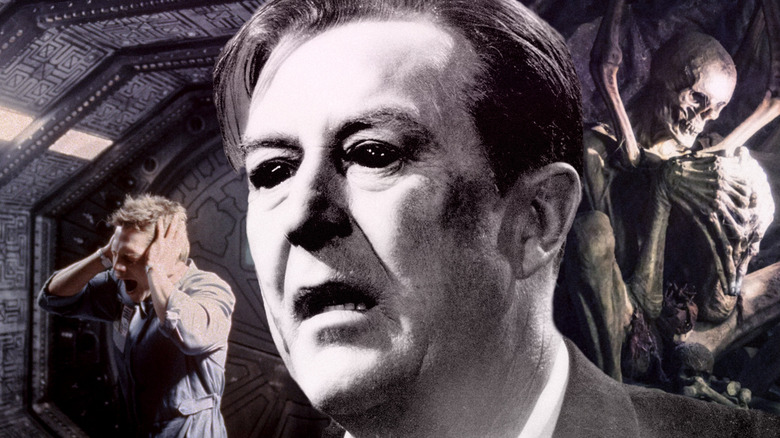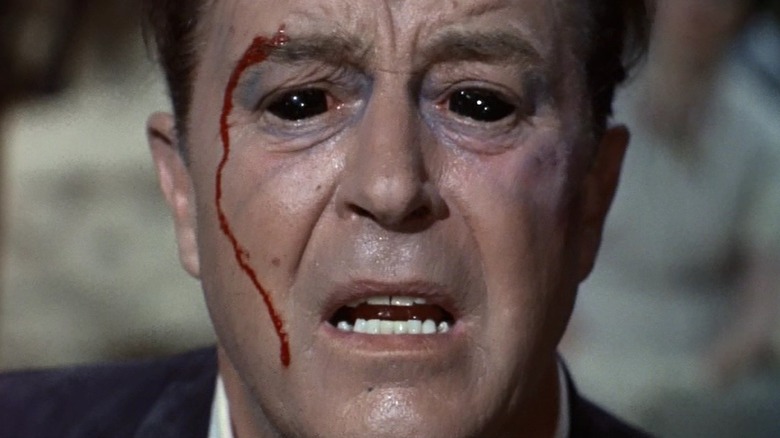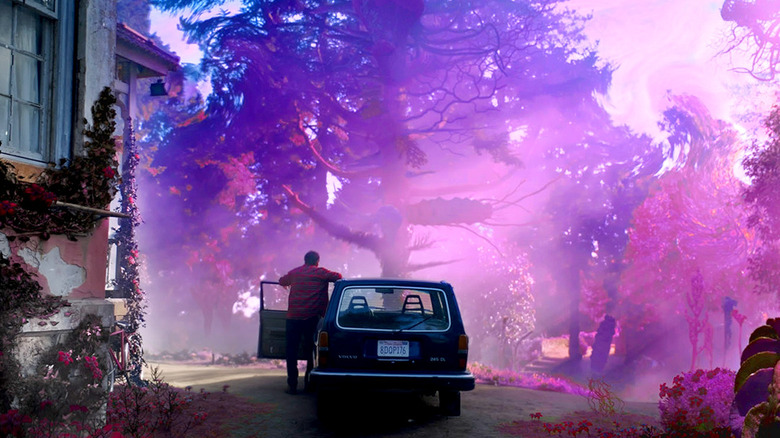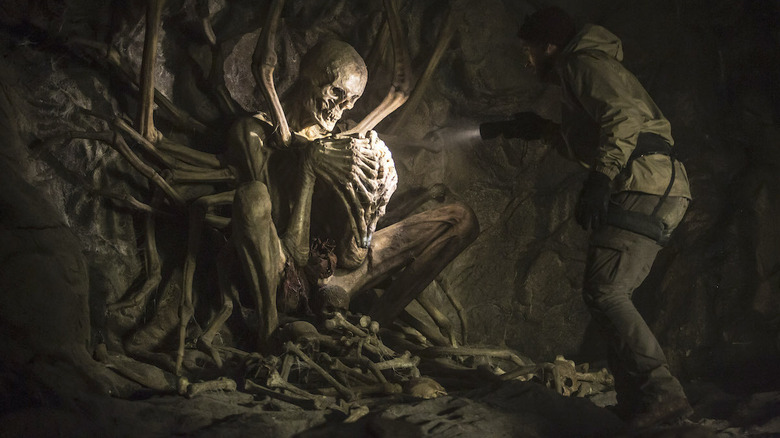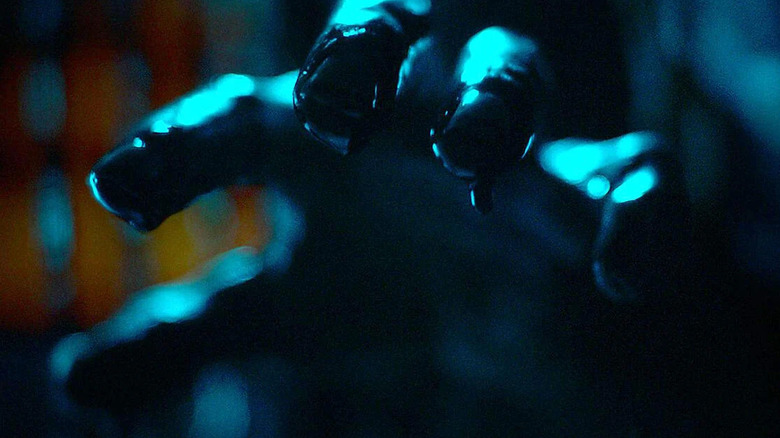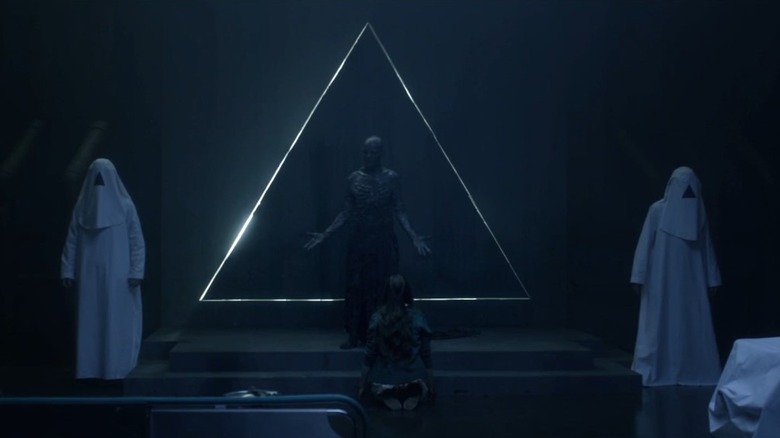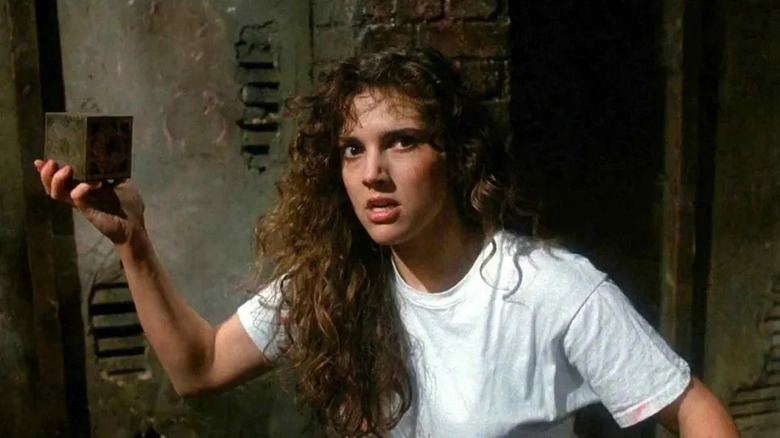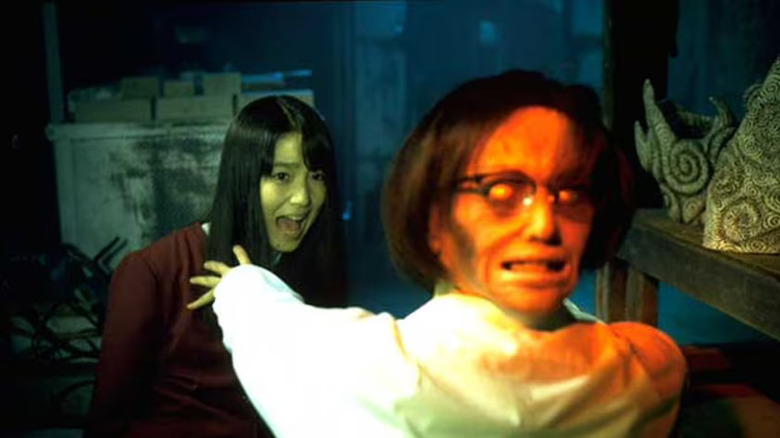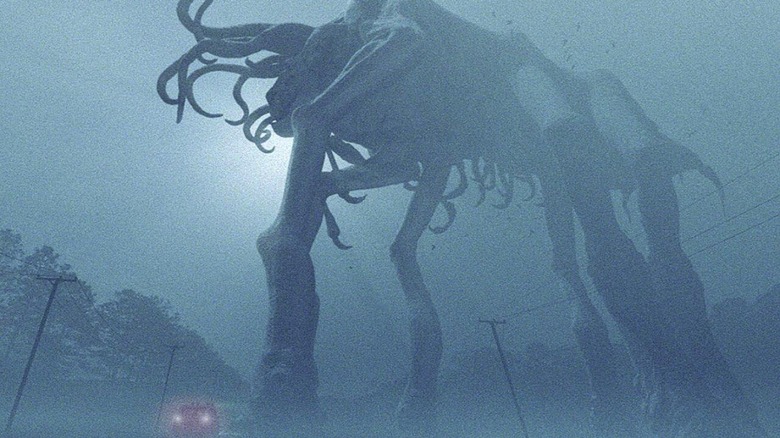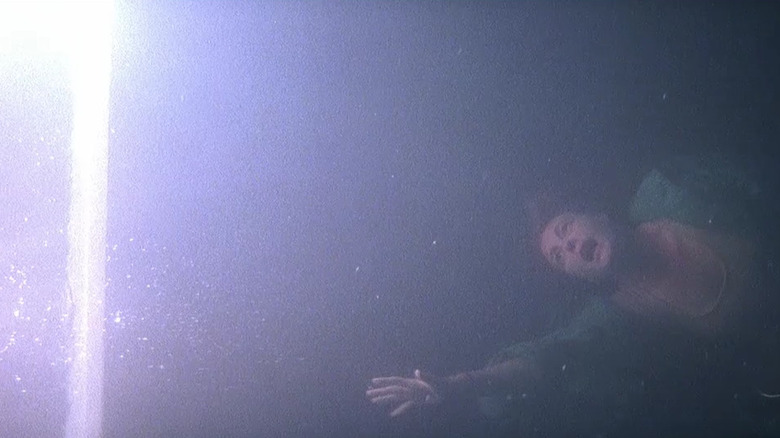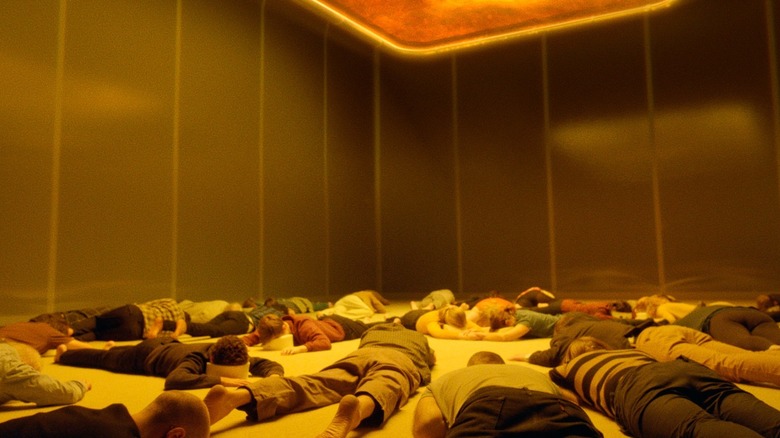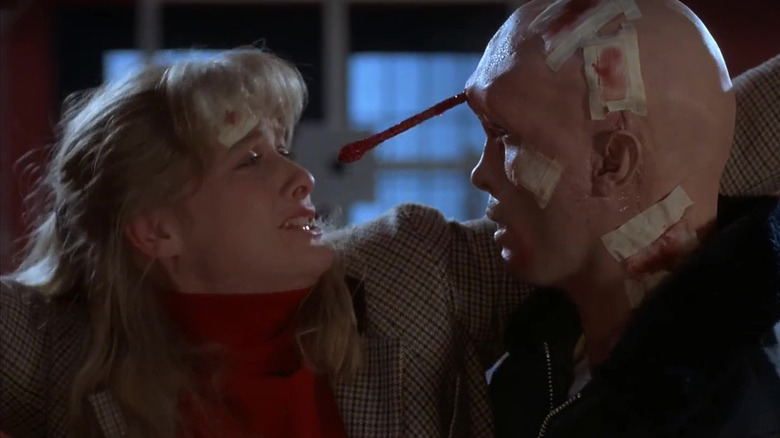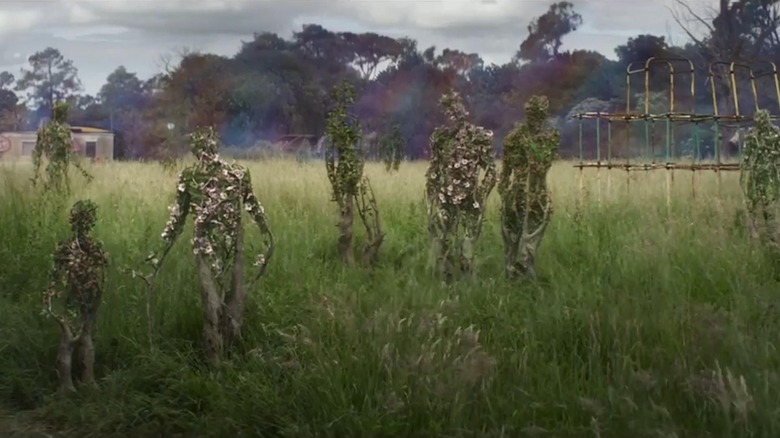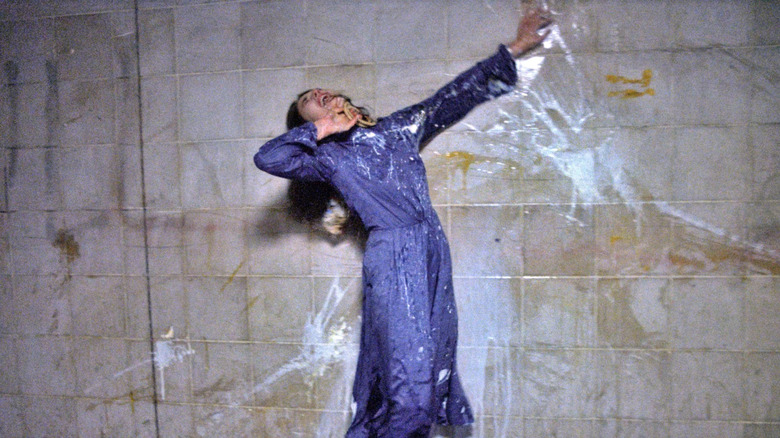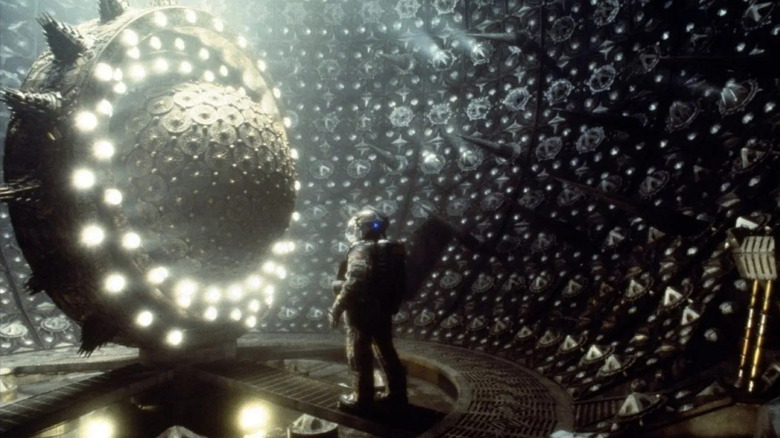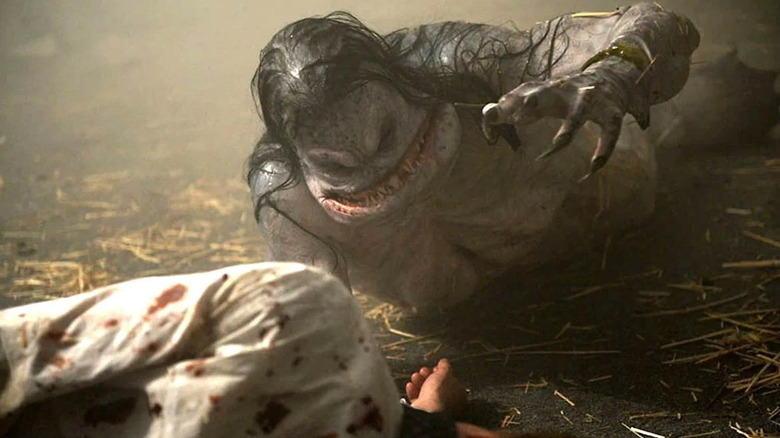15 Best Cosmic Horror Movies Of All Time, Ranked
The horror genre is one enormous tent filled with smaller, narrower categories — from slashers and eco-horror to ghost stories and folk horror. Most are pretty self-explanatory but one subgenre stands out as a bit more difficult to define, and it's called cosmic horror.
Birthed from H.P. Lovecraft's novels and short stories, and sometimes even referred to as Lovecraftian horror, cosmic horror is all about complete and overwhelming dread. Specifically, it's dread formed from our fears of the unknown and the discovery that we are merely an inconsequential mote of dust in the universe's grand scheme. Cosmic horror can come from the realization that there are intelligent beings beyond our scope of understanding, and any attempt to pry open the door between us and them — particularly efforts made through our primitive sciences — can only lead to loneliness, madness, and death. Alternately, accepting those truths breeds cults whose members embrace the unknown with dangerously open arms.
So, yeah, cosmic horror maybe isn't as much fun as horror-comedies, but it gets the job done.
It's worth noting that many cosmic horror lists include genre masterpieces like Ridley Scott's "Alien" and John Carpenter's "The Thing." You won't find them listed below, though, as they ultimately don't fit our definition. Both feature humans encountering deadly alien creatures, but they're less about the unknown and our minimal place in the universe and more about smart, capable characters squaring off against a physical, beatable alien monster. In these movies, the horror is both larger and less tangible.
X: The Man with the X-Ray Eyes
Some might dismiss 1963's "X: The Man with X-Ray Eyes" as just another cheap genre flick from the Roger Corman factory, but that would be a mistake. Corman directs this one himself — he's an underrated filmmaker behind the camera, and his directorial efforts deserve more love, so check out our list of his best films – and he takes what can easily be construed as a gimmick and turns it into an existential nightmare.
Ray Milland plays Dr. James Xavier, a scientist focused on the supposed limits of human sight. He invents an eye drop formula which he tests on himself, and soon he's able to see more than our biology previously allowed. He sees through clothes for cheap thrills and through flesh to help diagnose illnesses, but soon he's seeing through his own eyelids, through the surface of every physical thing, and still his vision grows. Ultimately, Xavier is made witness to the edge of the universe — where he sees something else looking back.
Color Out of Space (2019)
While H.P. Lovecraft is mentioned up top as basically the progenitor of cosmic horror, only two films on this list are directly connected to his stories. There are more than a few reasons for that, despite the dozens of Lovecraft adaptations over the years, but it ultimately comes down to too few of the films really featuring the cosmic horror element and executing it well. Richard Stanley's 2019 feature, "Color Out of Space," is the first of two exceptions that make the cut here.
Nathan Gardner (an increasingly, wonderfully erratic Nicolas Cage) moves his wife and three kids to a remote farmhouse, but the idyllic location is soon disrupted by the arrival of a meteorite that crashes into their land contaminating it with something ... other. Madness, mayhem, and monstrosities follow as the intergalactic substance plays havoc with flora and fauna alike. Stanley employs sharp, mesmerizing visual effects run through with a hauntingly powerful magenta to craft an alien atmosphere unlike any other. It's a beautiful nightmare.
The Empty Man
The epic journey undertaken by "The Empty Man" before reaching the screen was something of its own cosmic nightmare, but it's the film's content that earns it a place on this list. David Prior opens his feature debut with a beautifully atmospheric and eerie prologue set in a wintry landscape as a group of friends discover something evil beneath the snow. It works as a short cosmic horror film all on its own before opening up to the main storyline involving an ex-cop searching for a missing girl and finding an unspeakable truth instead.
The always reliable James Badge Dale headlines as a man struggling with grief and desperately holding onto the idea that he can solve this mystery. Elements of creepypasta-like urban legends and even creepier cult encounters lead him towards an unraveling of everything he thought he knew about both the world and his own life. Dread courses through the film's sleekly atmospheric cinematography as hopelessness and horror threaten to take up permanent residence in his soul.
Baskin
Can Evrenol's "Baskin" kicks off something of a hellish trilogy with the two films directly below as folks find themselves caught up in an absurd, guignol-painted landscape and facing off against true believers. Five police officers head towards a small village in response to a distress call, but they realize too late that they're the ones in need of help and understanding — neither of which is coming anytime soon.
The film sees its characters wade unknowingly into a grotesque and gory purgatory, and while their behavior as cops might warrant just such a punishment, it's still a nightmare, fusing Lucio Fulci-like dream logic with unspeakable horrors. A central theme posits that hell isn't somewhere we go, it's something that we carry with us, but it's no less tangible for it. The men have somehow landed in the liminal space between this world and one run through with visceral suffering. Surrounded by those who've already given themselves over to this new reality, the men struggle but fail to understand their own.
The Void
Two of the more visually impactful elements of cosmic horror are Lovecraftian creatures and unsettling cult members, and while some films on this list feature one or the other, "The Void" goes all in on both. A simple setup sees a handful of people holed up in a rural hospital as all hell breaks loose both inside and out. Murderous cultists circle the building outside while monsters and maniacal victims roam the halls in preparation for interdimensional terrors.
No film has ever gone wrong finding inspiration in John Carpenter's "Assault on Precinct 13" and "Prince of Darkness," and directors Jeremy Gillespie and Steven Kostanski use that strong base to hold up a wonderfully weird descent into the unknown. Most of the film's low budget has seemingly gone to creating wicked and wet practical effects, but all of it works to set a madness-fueled tone. A portal to another dimension — and the beings on the other side of it — are promising heaven but delivering hell, and it's a theme that leads well into the film below.
Hellraiser
Clive Barker was an incredibly fresh voice in the horror genre when he made his fiction and film debut back in the 1980s. That's evident in his wildly imaginative monsters and the visual scope of his creations, but it's equally clear in his intertwined embrace of pain and pleasure. "Hellraiser" and its ever-growing franchise universe are fueled by that pairing in ways both gnarly and gorgeous, as a man focused only on satisfying his own physical hungers opens a puzzle box to reveal the unlikeliest of hells.
The cenobites — leather-clad beings who were once human but have now been altered by their desires — are denizens of another dimension who freely admit to being "demons to some, angels to others." They're as audacious a film "monster" as you're likely to find, and they can't help but to leave witnesses in various states of awe, dread, and disbelief. They aren't logical creations; nothing about them makes sense as we know it, and their existence challenges any attempt at rational understanding. Still, secretly, in the recesses of our minds, we wonder what it would feel like to submit to their ways.
Uzumaki
Cosmic horror is built on the unknown and the unknowable, but it's fair to say that many of the films exploring it still use familiar settings and situations built on our shared knowledge. Some play off udeo-Christian concepts of Hell while others invoke alien landscapes or shadowy monsters. Junji Ito's mind works like no other, though, so his slice of cosmic horror greatness stands as a uniquely odd nightmare finding its horror in the banal.
"Uzumaki" sees a small town descend into absurd chaos as the people slowly become obsessed with spirals. They start seeing the shape in everything from their soup to the clouds above. Soon that obsession takes physical form (with a side of body horror) as some turn into human/snail hybrids, others kill themselves in spiral-related ways, and dread becomes the norm. The film never attempts to explain itself, and we're left only to accept that some unknown schism has left this town and its people caught in a constantly twisting reality.
The Mist
For most of us, the greatest danger on a misty, foggy day is the possibility of car accidents, but the residents of the small New England town of Bridgeton aren't that lucky. Impossible creatures roam the shrouded town, and as the population dwindles, the fear, paranoia, and human horrors grow. Those last bits are born in people's inability to understand what's happening around them, and everything they think they know is called into question when couch-sized mosquitos arrive.
Both Stephen King's novella and Frank Darabont's adaptation of "The Mist" offer up a possible explanation for why things are happening — a secretive military base nearby has been doing some strange experiments! — but neither commits to truly explaining the events. The only thing that's clear is that a doorway has been opened between our world and some other. Monstrous beings we could never have imagined are crossing over, and the universe has made it clear that humans are no longer top of the food chain. The film's ending goes a step further than King's story as the utter dread of their situation leads the survivors to take a desperate step — with devastating consequences.
Prince of Darkness
Three of John Carpenter's films are often lumped together as an unofficial Apocalypse Trilogy, and each has found its way onto various lists of cosmic horror films. "The Thing" and "In the Mouth of Madness" are undeniable classics, but it's "Prince of Darkness" that truly stands out as a frightening and fun piece of cosmic horror. A handful of quantum physics students head to an abandoned church to investigate a swirling jar of goo that might just be the devilish son of an ancient anti-god, and none of that is good news for humankind.
Carpenter's film fuses science with the trappings of religion only to reveal that both are woefully unprepared for the truth. This isn't religious horror as we know it; this is a story about a world-ending being trying to force its way into our dimension through fear, mathematics, and the slavish behavior of zombified followers. Characters try to nail it all down with scientific jargon, but when the end comes it's dripping in dread over the unknown. Add in Carpenter's best score (it's true!), and we're left with a cosmic horror classic that'll have you scared of your mirrors.
Aniara
Cosmic horror is most often accompanied by monsters and/or other dimensions, but "Aniara" stands alone on this list as the only film populated solely by human beings. Yes, there's a science fiction element as a spaceship carrying hopeful emigrants from a dying Earth head to their new home, but the horror and dread build strictly on the backs of people growing more and more terrified by their situation. The result is a truly disturbing journey to nowhere.
The spaceship is knocked off course without functioning engines and left to drift in a straight line through the vast emptiness of the universe. Days, weeks, months, and years pass, and the survivors try to work through it. Things turn dark when the realizations settle in, though — they have no hope of rescue, they will die alone, and they're constantly made to recognize the immensity of space and their inconsequential role in it. We see the harrowing effect of that dread in both individuals and groups who cling to anything and everything in a desperate attempt at fending off reality, but it only serves to make things even worse.
From Beyond
Stuart Gordon's most beloved and well-known Lovecraft adaptation is the gloriously over-the-top "Re-Animator," but his immediate follow-up is arguably an even better movie and definitely the stronger ride through cosmic horror. "From Beyond" has scientists keen on fiddling with pineal glands inventing a machine called the Resonator to help people see beyond our normal spectrum. Shades of "X: The Man with X-Ray Eyes" don't bode well for these eggheads, and soon enough otherworldly creatures are swimming through the air, taking bites, and pulling people into their dimension.
Like "Color Out of Space," Gordon's film uses a swirl of colors to signify when the portal is opened as pinks and purples fill the air alongside the creatures. That, combined with some stellar practical effects, works to create a heightened atmosphere where anything and everything is possible. That said, you still won't be prepared when a phallic worm inches its way out of Jeffrey Combs' forehead... and Barbara Crampton's leather-clad scientist bites it off.
Annihilation
While it's never officially been labeled as such, Alex Garland's "Annihilation" — an adaptation of Jeff VanderMeer's novel — feels very much like a loose riff on Lovecraft's "The Colour Out of Space." A meteorite impact creates something called the Shimmer, a slowly expanding area where flora and fauna are distorted in ways both beautiful and grotesque. Now, five female scientists are heading in to figure out what happened to a previous team.
The film offers up a steady supply of strange, mysterious, and inexplicable phenomena that the scientists are frequently and woefully unprepared for. As the Shimmer grows, so too does the dread and terror at what it means and where it will end. Endings, of course, are part of the themes at play as the film touches on humankind's tendency towards self-fueled implosion. The way we handle grief is also a throughline here, but these depressingly heady ideas never overwhelm the wonder and the terror of it all. A stellar cast including Natalie Portman, Jennifer Jason Leigh, and Gina Rodriguez helps sell the existential nightmare all the way through its thought-provoking ending.
Possession
Many, if not most, of the films on this list deliver strange, unsettling journeys into the unknown, but none are as willfully and wonderfully dense as Andrzej Zulawski's "Possession." That's a compliment, by the way. The film works as a real mindblower regardless of how much of it you think you understand. It's also why "Possession" took its time becoming a true cult classic. A spy returns home to West Berlin to his wife and child, but her desire for a divorce leads the couple into a combative hell en route to a twisted rebirth.
Zulawski wrote the film while undergoing his own brutal divorce, and the themes of separation — between husband and wife, between parent and child, between East and West Berlin — carry characters forward even as the world around them crumbles into a strange, dread-filled chaos. A tentacled creature, possibly real and possibly imagined, grows and copulates in the darkness, and as the film ends the outside world sounds as if its on the brink of destruction. "Possession" is utter madness and highlighted by the most disturbingly effective breakdown ever captured on film, courtesy of Isabelle Adjani.
Event Horizon
Humankind's need to discover more has led to numerous advances and scientific wonders, but sometimes a fancy gravity drive designed to essentially teleport you through space is a really bad idea. A spaceship responds to a distress call from a vessel that disappeared years prior, and they discover too late that the drive has pulled something terrifying from whatever dimension it passed through. "Event Horizon" sees its characters experiencing a horrifying descent into cosmic horror on the edge of the cosmos itself.
Paul Anderson's film was butchered by its studio, but even in truncated form it succeeds at capturing and portraying the horror of it all. Characters succumb to hallucinations that twist their most personal fears with dread and doubt, and physical violence soon follows. The possibility that the other dimension may actually be as close to hell as our minds can contemplate only adds to the terror they're feeling lost in an uncaring cosmos and quickly nearing a horrifying end.
The Cabin in the Woods
It might seem odd to put a comedy at the top of a list about cosmic horror, given the subgenre's focus on dread, but we're doing it anyway. Drew Goddard's "The Cabin in the Woods" is a horror-comedy that delivers scares and horror iconography while still managing a fun tone and big laughs. It starts like a typical slasher as five friends head to a remote cabin only to awaken some undead redneck zombies, but it's soon revealed that the grisly deaths are all in the service of appeasing the Ancient Ones. The old gods leave humankind alone as long as they get their sacrifice.
Technicians put their faith in science and gadgetry to control and contain the epic horror, and the archetypal victims struggle to grasp the magnitude of what's actually unfolding around them. Those in the know feel the approaching dread as they tick ever closer to the end of the world as we know it, but they didn't count on a resilient, would-be victim stoner named Marty who's just fine letting humankind come to an end. It's brilliant, hilarious, and filled to the brim with monstrous creations, meta commentary on horror cinema, and the Lovecraftian idea that bigger, older, and more frightening gods than our puny minds can even imagine exist just beyond the veil.
